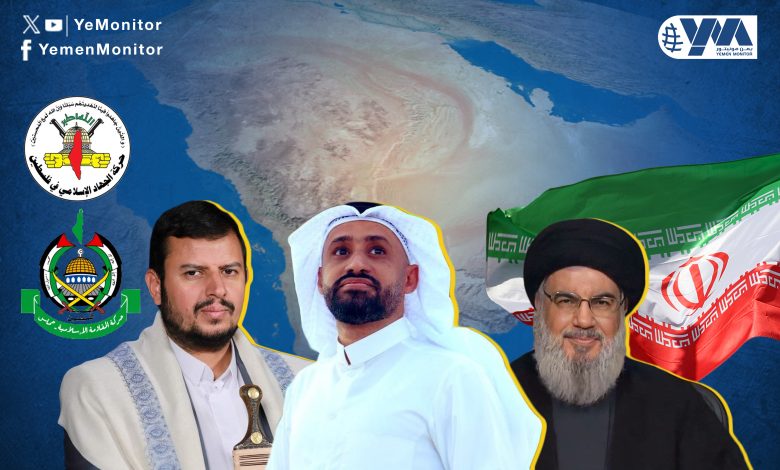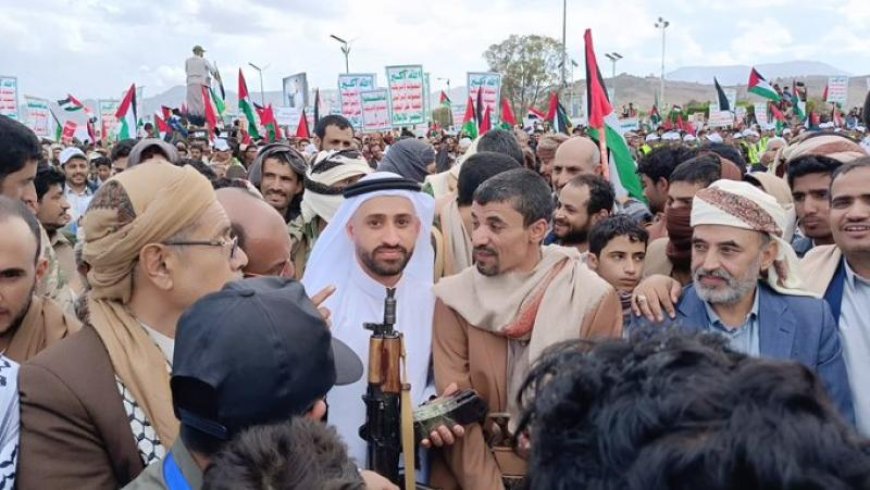
AR
Yemen Monitor/Special Analysis:
Summary: The Red Sea war gives Iran an opportunity to make the Houthis a new regional center to implement its expansionist ambitions, export the revolution to Gulf countries, and keep the region and international interests under threat.
In recent weeks, Sana’a has been revealed to be more involved in being an alternative to Iranian-backed groups instead of Tehran and Beirut; while the Houthis are investing in considering themselves a source of inspiration for Shia opposition movements in the Gulf states.
Since November, the Houthi armed group has launched more than 60 attacks on commercial ships in the Red Sea, claiming to support Palestine; Iran has always encouraged these attacks, which are popular in the Arab world and Africa due to decades-long Western policies against these countries.
Tehran presents the Houthis – the most enthusiastic to establish their presence in the Iranian-led “resistance axis” – to its allies as regional leaders in a new multipolar world that it promises alongside Russia. Iran has always achieved profitable results from the Houthis at a low cost in lives and money compared to the price it pays in Lebanon, Syria, and Iraq.
Since its inception in 1979, the Iranian Revolution has exported itself to the Islamic world; This task was assigned according to the Iranian constitution to the Revolutionary Guard and its external allies, “Al-Quds Force”. Lebanon was a regional center for the Iranian Revolution through which its agents and clients in Yemen, the Gulf Arab states, Syria, the Arab world, and even African countries passed.
But after a decade of Hezbollah’s wars in Syria and the killing of hundreds of thousands of civilians by the Lebanese militia – which admits that it is fully affiliated and funded by Iran – its popularity in the region has declined. Therefore, Iran presents the Houthis as the new spearhead in the region, and a model for its ability to confront the Western colonial powers that have dominated the world for decades.
Although the new Iranian approach gives the Houthis local and regional goals, it will withdraw the Yemeni group from implementing agreements signed by Iran, including agreements related to the ongoing brutal Israeli aggression against Gaza Strip, which has killed 33,000 civilians, more than two-thirds of whom are women and children.
Palestinian resistance movement….. relocating to Sana’a instead of Lebanon
Discussions for a ceasefire in Gaza are taking place in Doha, where the office of the Islamic Resistance Movement (Hamas) is located where representatives of other Palestinian factions are also present, and Cairo the Egyptian capital on the Palestinian border. Leaks suggest that the United States has requested Qatari officials to put pressure on Hamas to accept Israeli conditions otherwise expel the office leaders from the Gulf state.
If this happens, the office leaders may have no choice but to move to Iran. Qatari officials and journalists claim that it is possible for Hamas leaders to move to Sana’a, the Houthies-run areas, instead of moving to Tehran. They argue that relocating to Sana’a would maintain the Arab depth of Palestinian resistance, as the departure of resistance leaders with the support it receives from Iran gives “Persia” more popularity in the Arab world, and increases pressure on the Arab regimes.
However, unlike that, Hamas moving from Doha to Tehran-controlled Sanaa integrates the movement further into the system of the” Vali-e-Faqih” (Guardianship of the Jurist) and its plans, achieving the goal of Israeli occupation by linking the Palestinian resistance to Iran to facilitate its normalization with Arab countries. This also makes Tehran the controller of important Arab national security issues. Hamas usually denies representing Iranian interests and emphasizes its Arab identity, stating that they only turned to Tehran after Arab nations turned their backs on the Palestinian cause.
The matter extends further, as an informed Arab diplomat told “Yemen Monitor” that there are Western and Arab suggestions to resolve the Israeli demands issue by moving resistance leaders out of Gaza to Sanaa after the war.
Furthermore, they suggest – according to the source – “transferring resistance leaders from Lebanon to Sanaa to ease tensions between Israel and Hezbollah,” which Iran seeks to prevent from being affected by any war in the foreseeable future for fear of losing control of the current game.
The centrality of “Sanaa” in Iran’s strategy seems to be shifting, as an official in Sanaa told “Yemen Monitor” that a meeting was held in Sanaa for leaders and representatives in the resistance axis, including Houthi, Palestinian, Lebanese, Iranian, and Iraqi leaders, some from Hamas and “Islamic Jihad movement” at the beginning of March last year, to coordinate operations in the Red Sea in response to Israeli escalation in Gaza, and Western mobilization in the region.
It was later followed by several meetings that led to the establishment of an operations room to monitor the events of the war, coordinate positions, media tools, and attacks, including monitoring what is happening on the ground in Gaza and southern Lebanon.
In the past, meetings of the resistance axis representatives were held in Lebanon, where there are offices and representatives of Iran-affiliated movements and officials from the Revolutionary Guard. Although meetings were held in Iran, the coordination remained in Lebanon. Houthis were usually in a precarious situation during these meetings, due to various religious and political considerations, especially following the Iranian-Saudi agreement in March 2023.

Center for Opposing the Gulf Kingdoms
The Iranian/Saudi agreement dominates the relationship between the two countries after 2023, putting the two countries in a relatively comfortable position – despite the ongoing security dilemma – as it prevented the escalation of tensions and the extension of Gaza War into a regional war. However, this does not mean that the regime in Tehran has backed down from its plans to expand and export the revolution outside its borders.
The agreement with Saudi Arabia extends to Iran’s proxies in the region, as it stopped the attacks from Yemen, and the hostile statements of its militias in Iraq, Syria, and Lebanon have also calmed down. This includes Hezbollah, where reports indicate that there have been communications between them seeking to resolve the Lebanese crisis, the last of which was in January 2023.
Lebanon hosts many Shia Saudi opponents. Among them is Ali Hashim Al-Haji, who threatened in August 2022 to “exterminate everyone in the Saudi embassy” in Lebanon, weeks after a large conference that brought together Saudi opponents who said their mission was to “overthrow the Al Saud regime.”
Last month, it was announced in Sana’a that “Ali Hashim” had arrived amid celebrations by Houthi leaders, burning his Saudi passport, and announcing the start of a new phase of opposition to the Saudi regime that includes weapons training and organization.
It is not known how “Ali Hashim” arrived to Yemen from South Lebanon or when he arrived. However, information indicates that many of Iran’s followers, including Saudi opponents, Hezbollah leaders, and the Revolutionary Guard, have arrived by sea in the past three months to Houthi areas with the start of US-British attacks on Yemeni territory to target Houthi weapons and warehouses.
There is also no accurate information on the number of Saudi opponents in Yemen. The arrival of “Ali Hashim” to Sana’a may be part of the Saudi understandings with Hezbollah to get the opponents out of South Lebanon or hand them over. But for the Houthis, who are pressuring the kingdom to sign an agreement that implements their conditions to end the war in Yemen, the presence of the opponents is part of an ongoing approach that has been going on for years.
In 2018, the Houthis announced their welcome to Saudi opponents in their areas of control. In November of that year, a Saudi opponent named “Dakhil Al-Qahtani” announced from Sana’a the establishment of the “Movement for the Liberation of the Arabian Peninsula.”
The sources spoke to “Yemen Monitor” on condition of anonymity due to the sensitivity of the topic.
Source of Inspiration
Over the past decade, the Houthis have repeatedly claimed ownership of the Yemeni territories of “Jazan, Najran, and Asir,” which are Saudi border regions. In their celebrations in Sana’a, they make sure to display tribal delegations from these areas, believed to be Saudi oppositionists.
Politically, the Houthis present themselves as leaders of the Arabian Peninsula and a source of inspiration for Shia groups in the Gulf. In 2019, they spoke about carrying out operations on Saudi oil facilities west of Riyadh with the cooperation of Saudis in the Eastern region.
“Yemen Monitor” previously published an analysis in 2019 indicating that any “agreement” giving the Houthis a victory to remain a force in Yemen and a “fourth capital for Iran” would strengthen Shia minorities within the Kingdom of Saudi Arabia and the rest of the Gulf countries. Yemen could serve as a starting point for Shia/Iranian activity within the kingdom and other Gulf nations, inspiring these groups. With Iranian weapon technology in the hands of the Houthis, it could potentially extend to other Iran-affiliated groups.
In October of last year, Houthi media reported an operation targeting American military bases in Saudi Arabia, claimed by the “Liberation of the Two Holy Mosques Movement” in support of Gaza. There is no neutral information regarding whether these operations actually took place, but Saudi journalists claim that there is a movement in Sana’a led by a person named “Hamoud Abu Masmar.” Houthi leaders claim that he is the grandson of a chief of the “Abi Arish” area in Jizan, southern Saudi Arabia, and they are betting on him to regain control of his grandfather’s principality and rule over the Hashemites in southern Saudi Arabia.
The Political Agenda of the Houthis
In all cases, the Houthis have not been open about their political agenda, the form of the state after the war, and their foreign relations. However, they see comparing them to Hezbollah as incorrect. Houthi leader Abdulmalik Al-Ajri said that his group would be “stronger and larger” than its Lebanese counterpart (affiliated with Iran) because the Houthis would be “the main player and stakeholder” in Yemen.
The Houthis often compare their strength, influence, and plans to be a regional power in the region depending on Iranian power. During the war years, the Houthis copied the revolutionary system, including parallel military institutions. This makes them have a theory to export what they call the September 21, 2014 revolution to the countries of the region.
Al-Ajri believes that Abdulmalik Al-Houthi, “the leader of the group,” will remain the supreme political authority in Yemen under any future government, “because his authority comes directly from the people and therefore it is not negotiable,” as is the position of the Supreme Leader in Iran.
Whether the Houthis want to become a new regional center for the Iranian revolution or have the ambition to be a new Iranian regime in the region, this would be the greatest threat to national security not only for the Gulf Cooperation Council countries, but also for East African countries and the global economy, which will remain under threat.
This reduces the solutions available to the countries of the region and the international community, foremost of them is Yemen. Otherwise, the region is heading towards a new phase of the Iranian revolutionary interventionist policies in the region and the world that will last for decades, more deadly and threatening to the national security of the Arabian Peninsula, the Horn of Africa, and international trade.





